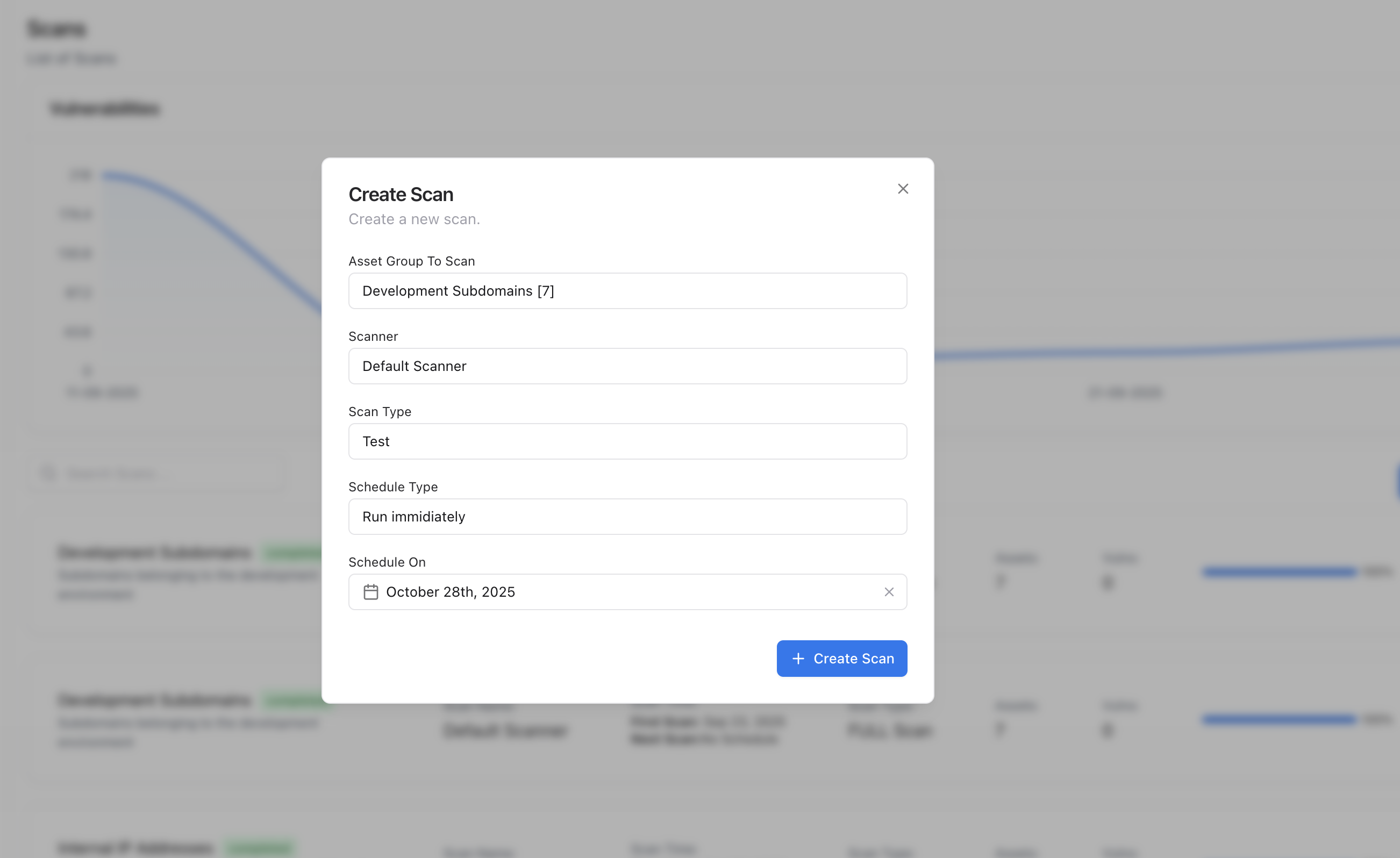It allows security teams to initiate discovery scans, track their progress, and monitor how your external footprint evolves over time. Each scan performs deep reconnaissance across multiple sources — DNS, IP ranges, certificate transparency logs, and third-party datasets — to uncover every publicly accessible asset related to your organization.

Scans overview showing discovery trend and scan progress
Overview
The Scans page presents a dashboard view and a list of executed scans, providing full visibility into the discovery process and historical changes in your attack surface. Key Highlights:- Track discovery trends over time.
- View each scan’s status, progress, and execution date.
- Measure growth or reduction in total detected assets.
- Identify newly added or removed assets since the last scan.
Asset Discovery Trend
At the top of the page, a dynamic graph visualizes the total number of assets detected over time.
Discovery trend line showing assets detected per scan
- See how your attack surface expands or contracts across scans.
- Evaluate the impact of remediation actions.
- Identify unusual spikes that may indicate new deployments or shadow infrastructure.
Scan List

Scan list showing domain scans, asset counts, and execution status
| Field | Description |
|---|---|
| Target Domain | The root domain or scope of the scan. |
| Status | Displays whether the scan is Running, Completed, or Failed. |
| New Assets | The number of assets discovered for the first time in this scan. |
| Total Exposures | Exposures detected during the discovery process. |
| Execution Date | The date the scan was executed. |
| Progress Bar | Visual indicator of the scan’s completion percentage. |
- 🟢 Completed — Scan successfully finished and results are available.
- 🔵 Running — Scan is in progress; assets are still being discovered.
- 🔴 Failed — Scan could not be executed (connectivity or configuration issues).
Creating a New Scan

Create new scan modal for initiating discovery
A modal will appear, prompting you to enter the root domain or target organization. Once created:
- The scan automatically begins enumerating all related subdomains, IPs, certificates, and technologies.
- Progress updates in real time under the Running state.
- Upon completion, newly detected assets are added to the Asset Catalog.
How Scans Work
Each scan performs a multi-layered discovery process, combining:- Passive Discovery — certificate transparency logs, WHOIS data, ASN mappings, public datasets.
- Active Enumeration — DNS brute-forcing, subdomain resolvers, and HTTP fingerprinting.
- Asset Enrichment — correlating discovered items with IPs, ports, and technologies.
- Exposure Detection — scanning for misconfigurations, open ports, and public access.
Continuous Monitoring
By scheduling scans periodically, ASM enables continuous asset discovery.This helps you stay ahead of emerging risks by:
- Detecting newly exposed assets in near real time.
- Tracking changes to existing infrastructure.
- Monitoring for re-emergence of deprecated systems.
- Quantifying the impact of remediation and hardening efforts.
Best Practices
- 🕒 Run scans regularly — weekly or monthly to maintain up-to-date visibility.
- 🎯 Scope scans smartly — include all known domains and third-party integrations.
- 🔁 Correlate results — review detected assets under the Asset Catalog for validation.
- 📈 Monitor trends — use the asset detection graph to assess ROI of remediation efforts.
Value to Security Teams
| Benefit | Description |
|---|---|
| Automated Discovery | Continuous scanning ensures no external asset is missed. |
| Attack Surface Reduction | Identify, prioritize, and remove unnecessary exposures. |
| Historical Tracking | Compare asset counts across scans to track posture improvements. |
| Operational Efficiency | Save manual effort through automation and real-time enrichment. |
Next Steps
Explore Asset Catalog
View all discovered assets including subdomains, IPs, certificates, and technologies.